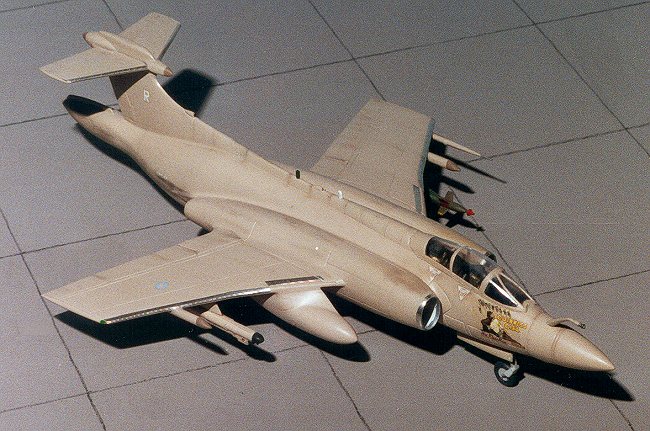
Matchbox 1/72 Buccaneer S.2B
|
KIT # |
PK 106 |
|
PRICE: |
$10.00 when new |
|
DECALS: |
Two aircraft |
|
REVIEW : |
|
|
NOTES: |

|
HISTORY |
The Buccaneer was the Royal Navy's last non-VTOL fixed wing strike aircraft. About 58 of them were built to RN specifications. One of them being the need for a large weapons bay and the ability to fly fast and low. The Buccaneer was by no means a supersonic aircraft, but was able to reach speeds of 645mph in a clean condition. However, this was generally not its normal operating condition as up to three pylons per wing could be added. In actual use, the weapons bay was not used for ordnance, but was generally used for a fuel tank to increase the range of the aircraft. In-flight refueling capabilities were also added to the aircraft.
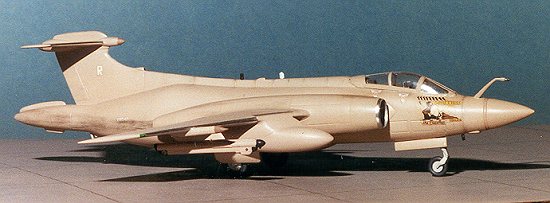 The RAF liked the
design as well and had 42 specifically built to their needs, both types being on
the production line at the same time. The total production, including those few
Mk.50s ordered by South Africa ran from 1968 to 1976 with just a bit over 110
airframes being completed.
The RAF liked the
design as well and had 42 specifically built to their needs, both types being on
the production line at the same time. The total production, including those few
Mk.50s ordered by South Africa ran from 1968 to 1976 with just a bit over 110
airframes being completed.
The RAF liked the aircraft and though they only saw service in four squadrons (12, 15, 16, and 208 as well as 237 OCU), kept them in service until the middle 1990s when the last of the type was retired from service and replaced by Tornados. In the final days it was used for sea strike. The types only baptism of fire in RAF service came with operation Granby, or the war with Iraq in 1990/91. In fact, it was only in the last few weeks that the Bucc was in action. It's main job was as target designator for the Tornado strike force, though some Buccaneers also carried LGBs.
|
THE KIT |
The Matchbox kit is one of those designed by 'the trencher' and has engraved panel lines that are probably a scale foot wide! Seriously, it does have some rather large engraved panel lines. It also has a very bare cockpit with just seat shapes and that is it. There are side consoles as part of the fuselage halves, but no control sticks and no instrument panel. This is sort of typical of Matchbox kits of that era. However the shape is quite good and with the help of aftermarket goodies, can be made into a nice model.
The rest of the kit is equally sparse in detailing. There are no weapons or ordnance options that I can remember. The kit comes with decals for the two RAF Germany squadrons; 15 and 16.
|
CONSTRUCTION |
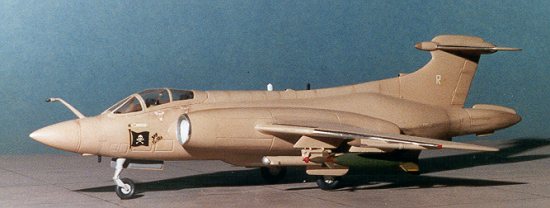 The actual
building of the kit is not a problem at all. As mentioned, it is quite basic
with not that many parts at all. However, I had to do something about the
cockpit. I had no intention of cutting the canopy and displaying it open, but
the kit seats had to go. Fortunately, Airwaves makes a pair of proper Buccaneer
bang seats, and so I chose to use them. The rest of the hole was painted flat
black, as on the real aircraft, but in this case it was done to hide the lack of
proper interior detailing!
The actual
building of the kit is not a problem at all. As mentioned, it is quite basic
with not that many parts at all. However, I had to do something about the
cockpit. I had no intention of cutting the canopy and displaying it open, but
the kit seats had to go. Fortunately, Airwaves makes a pair of proper Buccaneer
bang seats, and so I chose to use them. The rest of the hole was painted flat
black, as on the real aircraft, but in this case it was done to hide the lack of
proper interior detailing!
Once that was done, the tub was installed, nose weight added (and you'll need a lot as this kit is tail heavy), and the rest of the kit attended to. One of the benefits of large engraved panel lines is the ease at which they can be restored after puttying. I found that I used quite a bit of filler, mostly at the wing/fusealge join and around the intakes and exhaust. The intake interiors were painted white prior to gluing.
After I had a pretty complete airframe, it was time to figure out how to load up the aircraft. I knew I wanted to do a Desert Storm version as that was a hot topic at the time. However, I had to rely on aftermarket sources. From looking at several photos of Buccaneers, I chose the layout that I wanted and what seemed to be most often used. What I needed were wing fuel tanks, a set of underwing pylons, a laser-guided bomb, an ALQ-101 jamming pod, wing mounted ECM pods, and a target designator pod.
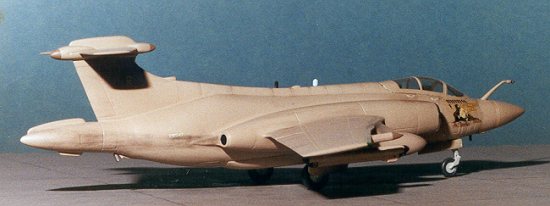 Most of these items were easily
available and though I don't remember exactly who provided what, most parts came
from Airwaves, Aeroclub and Kit Bits. The parts that had to be
installed prior to painting were the pylons and the slipper fuel tank. Those of
you who want to use the Airfix kit will find many of these items as part of the
kit.
Most of these items were easily
available and though I don't remember exactly who provided what, most parts came
from Airwaves, Aeroclub and Kit Bits. The parts that had to be
installed prior to painting were the pylons and the slipper fuel tank. Those of
you who want to use the Airfix kit will find many of these items as part of the
kit.
Granby Buccaneers usually only carried a single fuel tank and it was generally mounted on the right wing. They also usually only carried four weapons pylons, omitting the most outboard one. A modification made to all desert Buccs was the removal of the small wingtip extensions. This means that you have to sand off the outer wing bits and round off the corners. This was done to cut down on low level buffeting. I also glued on the target designator, wing ECM antennas and the jamming pod at this time as they were all to be painted the same color.
|
PAINT & DECALS |
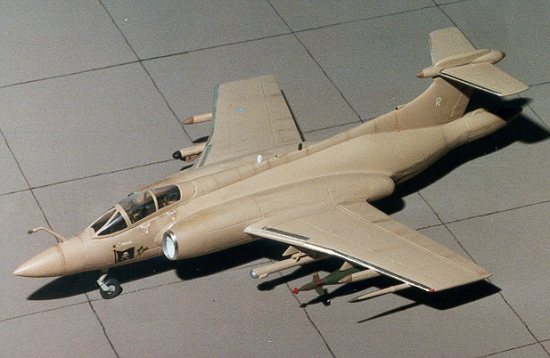 Once the canopy was glued on and
masked, the entire airframe was painted with Xtracolor Desert Pink. This is a
gloss enamel and took a few days to dry. Once that was done, the antenna tips
were painted an earth color. Then the landing gear bays were painted white and
the light aircraft grey landing gear were glued in. There were aftermarket
landing gear available, but I saved them for the Airfix kit!
Once the canopy was glued on and
masked, the entire airframe was painted with Xtracolor Desert Pink. This is a
gloss enamel and took a few days to dry. Once that was done, the antenna tips
were painted an earth color. Then the landing gear bays were painted white and
the light aircraft grey landing gear were glued in. There were aftermarket
landing gear available, but I saved them for the Airfix kit!
The decals came from a Modeldecal sheet that was available at the time. Choosing an aircraft was difficult, but I finally settled on the busty 'Guiness Girl', replete with mission markings. The 'Sky Pirates' jolly roger flag went on the other side. All of these flags had a different design skull and crossbones on them. The rest of the decaling was a short operation as these aircraft were minimally marked over the temporary camouflage. I then sprayed clear matte over the aircraft as they were not glossy!
|
CONSTRUCTION CONTINUES |
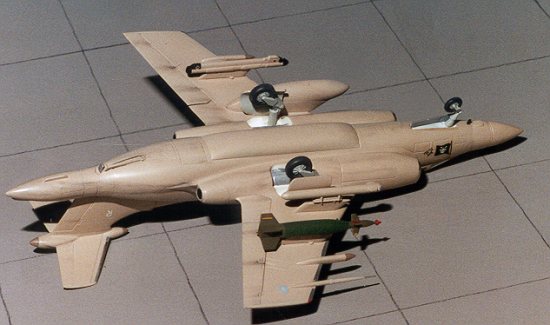 Once the painting and decaling were
done, it was time to add more 'stuff'. In this case the tissue came out of the
intakes and the intake rims were done with Bare Metal Foil. This was also used
on the 'blown slats' area of the aircraft along the leading edges of the wing,
and on the bare metal part of the tailplane. Then the gear doors and LGB were
glued in place. The panel lines were accented using a light rust pastel. A
darker brown was used in a number of other locations to simply grunge up the
aircraft as the desert pink got very dirty very fast. Any touchup painting was
then done and the whole airframe was then given a final coat of matte clear.
Once the painting and decaling were
done, it was time to add more 'stuff'. In this case the tissue came out of the
intakes and the intake rims were done with Bare Metal Foil. This was also used
on the 'blown slats' area of the aircraft along the leading edges of the wing,
and on the bare metal part of the tailplane. Then the gear doors and LGB were
glued in place. The panel lines were accented using a light rust pastel. A
darker brown was used in a number of other locations to simply grunge up the
aircraft as the desert pink got very dirty very fast. Any touchup painting was
then done and the whole airframe was then given a final coat of matte clear.
|
CONCLUSIONS |
Perhaps I shouldn't have chosen the Matchbox kit, but I didn't have an Airfix one at the time. Looking back on it, while it certainly isn't a contest kit, is still one of my favorites. The end result turned out very well and I'm glad I built it. There really were not any major construction problems and I don't see why anyone with even minimal skills couldn't duplicate it. I recommend it for all but the rivet-counters!!
|
REFERENCES |
Aircraft of the Royal Air Force since 1918, by Owen
Thetford, Putnam, 1979
AirForces Monthly, various issues circa 1990/91
September, 2000
Copyright ModelingMadness.com. All rights reserved.
Review kit courtesy of me and my wallet!
If you would like your product reviewed fairly and fairly quickly, please contact the editor or see other details in the Note to Contributors.
Back to Reviews Page 2020